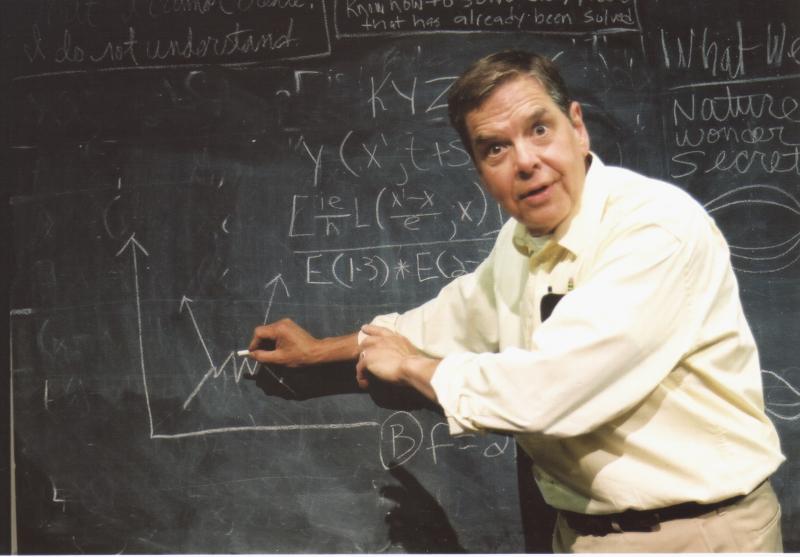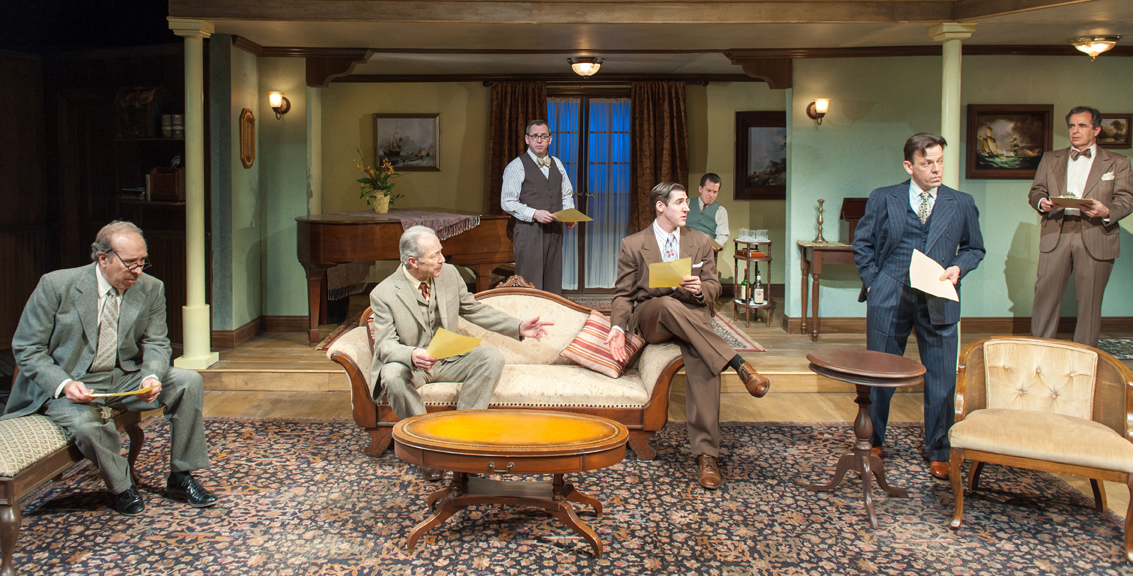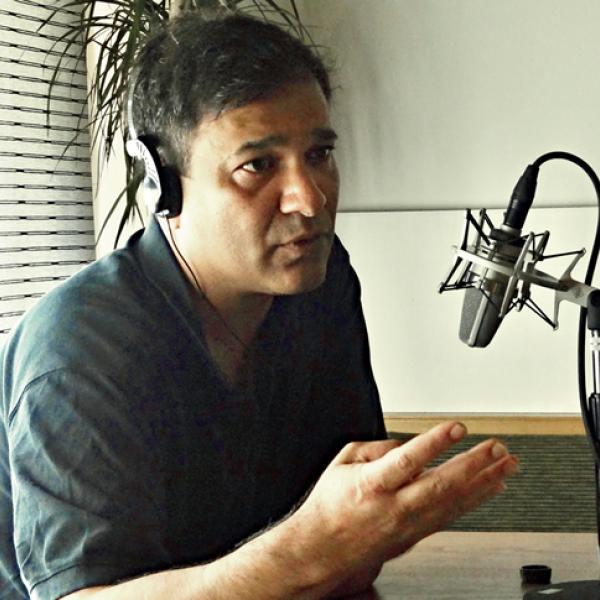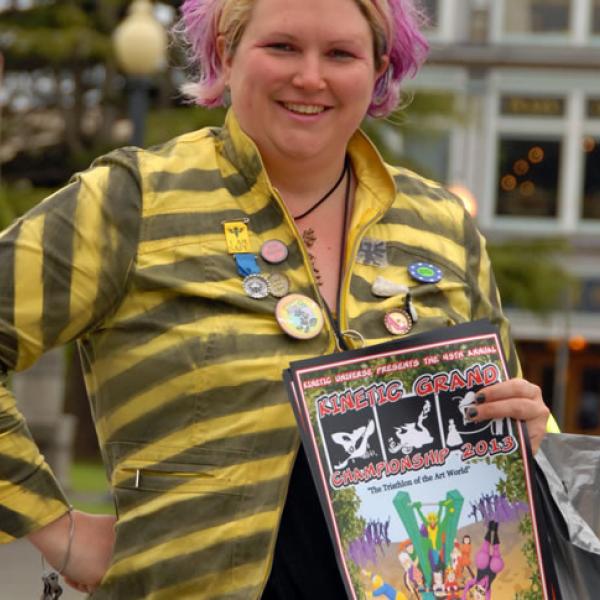Finding Common Ground

Keith Jochim in Peter Parnell’s QED, a play inspired by the writings of physicist Richard Feynman. Photo courtesy of Central Square Theater
If you believe the popular conception of artists and scientists as polar opposites, you might expect that putting them into a room together would lead to brawls, brouhahas, and well, big bangs. But, in fact, as theoretical physicist and novelist Alan Lightman and playwright Alan Brody have found out, the only explosions in the room are creative ones. In the early 2000s, the two men—both on faculty at the Massachusetts Institute of Technology (MIT)—decided to start a monthly salon for scientists and theater artists on MIT’s campus. The members of the resulting Science on Stage salons discovered not only common ground but also how, in many ways, artists and scientists are kindred spirits.
While playwrights and physicists might have sounded like strange bedfellows, theater proved a natural way to illuminate the human dimensions behind theories and equations. “The theater can raise questions that no other medium can raise in quite the communal way a play does. There are issues about science that very often don’t get expressed and don’t get discussed…. [having] to do with the moral dimensions of our research,” explained Brody. “We’re trying to find out what the human conditions behind science are, and that’s, I think, one of the greatest values that we have in the theater.”
Debra Wise, artistic director of Underground Railway Theater, was one of the salon’s participating theater artists. “The enterprise of theater, of course, is to raise and explore questions. I used to think before attending these Science on Stage salons that this was in contrast to the essential enterprise of science, which was to provide reasonings behind certain truths that were first discovered and then articulated,” she said. “Now I understand, actually, that one thing that scientists and artists have completely in common is we both demand of ourselves to sit in the middle of a question or a problem space for a very long time without running to one solution…. [I]t was a real epiphany for me as an artist, and I think to a certain degree to our colleagues who are scientists to see that the creative enterprise in both of our disciplines, in both of our domains, had that similarity.”

|
Brody said that he was particularly struck by the common passions that the group shared. “[I remember] a wonderful moment when Bob Jaffe, who’s a theoretical physicist, was talking about the nature of beauty in terms of equations, and it just blew my mind because he was talking about it in the same way we talk about it in the visual arts and we talk about it in the theater,” he said. “I thought, ‘They really do inhabit the same world we do with the same passions.’”
The group met monthly for more than a decade, engaging in spirited conversations around topics such as the intersection of religion and science. Each session began with discussion about recent theater productions and scientific developments. “And miraculously after about 15 minutes we would all settle on one of the topics that had been floating around… and the rest of the two hours would be spent talking about that topic,” remembered Lightman. “This is the way it happened every time…. What made it work was that we never had an agenda. Nobody ever had homework.”
Brody agreed that the open-ended spirit of the discussions was key to their success. “We didn’t feel that we had to get things done. We just talked. And it was simply astonishing how with the kinds of minds that were around that table, the kind of lively interchange that happened with nothing at stake.”
While MIT has made its reputation at the forefront of science and engineering, it was actually an ideal home for the Science on Stage salon, according to Leila Kinney, executive director of arts initiatives and MIT’s Center for Art, Science, and Technology. The university has a long tradition of fostering collaboration across the arts and the sciences—for example, visual artist György Kepes founded the Center for Advanced Visual Studies in 1967, and the university has a robust visiting artists program, recently hosting the likes of Trevor Paglen and Vik Muniz. MIT also had already dipped a toe into theater and science pairings with a symposium around a touring production of Michael Frayn’s Copenhagen, about a 1941 meeting between physicists Neils Bohr and Werner Heisenberg, and by partnering with Boston’s Museum of Science to produce staged readings of Peter Parnell’s QED, which imagines a day in the life of physicist Richard Feynman. According to Kinney, “There’s a lot that artists and scientists have to say to one another within the context of exploration, discovery, and experimentation.”
After a few years, some of the salon members began producing staged readings at venues on the MIT campus and around the community. One of its early productions was Brody’s Small Infinities, a play about Isaac Newton that was sparked during a salon discussion.
In 2005, Brody, Lightman, Wise, and the late playwright Jon Lipsky formally established Catalyst Collaborative@MIT to support theater productions about the culture of science. Around 2007, Wise’s Underground Railway Theater and the Nora Theatre Company moved into a new home—the MIT-owned Central Square Theater. Catalyst Collaborative mounted a theatrical adaptation of Lightman’s novel Einstein’s Dreams as its first full production in its new home. (Catalyst Collaborative recently received NEA funding to support a theatrical adaptation of another of Lightman’s novels, Mr g, scheduled to debut in early 2015.)
|
|
The project’s overall goal was not only to produce plays, but also, according to Wise, “to follow these [productions] with conversations that put audiences in direct engagement with scientists who were doing cutting-edge work in the scientific areas that were being explored.”
From the beginning, MIT participated in Catalyst Collaborative as much more than a landlord. “We have an advisory committee that’s chaired by Associate Provost Philip Khoury with responsibility for the arts. We actually review [the Catalyst Collaborative] season, the kinds of productions they’re thinking of doing, how that relates to major topics in science and research at MIT,” said Kinney. University scientists also sit on the project’s board, and scientists from MIT and other regional schools participate in post-show audience talkbacks.
Mimi Huntington, artistic director of the Nora Theatre Company, which has recently become a Catalyst Collaborative partner, acknowledged the importance of the scientific community’s participation to the project’s success. “We have such resources [at MIT], and that makes the program really rich. People we can talk to for getting the science up to date, and people who are really supportive and want to be part of the process—whether it’s talking to actors during rehearsal time in order to get them closer to whatever is being discussed in the play to having scientists and actors talking together at the talkbacks.”
While each season at Central Square Theater is partially populated by existing theater works, such as Bertolt Brecht’s The Life of Galileo, Catalyst Collaborative also commissions new work. For example, Melinda Lopez’s From Orchids to Octopi was developed thanks to a commission from the National Institutes of Health. “They mandated us to create a piece that would be equally powerful for a high school audience as for a general adult audience,” said Wise. “The takeaway from the play would be an understanding that evolution and natural selection were essential across disciplines of modern science.”
|
|
As part of the development process, Lopez and the creative team interviewed approximately 30 scientists on the science itself, what they thought the science meant for society as a whole, and the importance of Darwin’s seminal work The Origin of Species. The science community was also involved in readings of the play as it developed, in helping David Fichter design a mural that was a pivotal set piece, and in planning the content for symposia and audience talkbacks associated with the production.
All of the partners have been pleasantly surprised by enthusiastic reactions from both the scientific community and the general public. “I think the interesting thing about the Catalyst Collaborative is how receptive an audience they have found for these kinds of plays about furthering the public understanding of science, how willing and eager the scientists have been to participate in the dialogue, and that we just seem to be building an audience for this kind of thing,” MIT’s Kinney said. “I think it’s a wonderful sort of contribution to what we used to call a public intellectual discourse.”
Brody commented that the project’s success is a case of the right project at the right time. “I think we are in the vanguard for the theater to talk about what the world is like in the 21st century. That in talking about science and theater, this is the 21st century’s version of the 20th century’s psychological drama.”
Wise believes that, ultimately, the Science on Stage salons and Catalyst Collaborative are about more than using theater to encourage people to like scientists or understand scientific theories. “[It’s about] looking at science as a way of understanding our place in the universe,” she said. “Understanding that is a central part of our enterprise as a society.”








